Mon 28 Sep 2009
A Movie Review by David L. Vineyard: MAN HUNT (1941.)
Posted by Steve under Reviews , Suspense & espionage films[4] Comments
MAN HUNT. 20th Century-Fox, 1941. Walter Pidgeon, Joan Bennett, George Sanders, Roddy McDowall, John Carradine. Screenplay: Dudley Nichols, based on the novel Rogue Male by Geoffrey Household. Director: Fritz Lang.
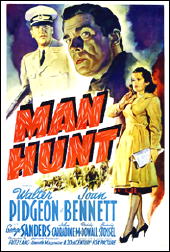
Few books catch the public imagination the way Geoffrey Household’s classic novel of chase and pursuit Rogue Male did. It was a best-selling phenomenom and became one of the classic thrillers of all time, near the top of everyone’s list of the best thrillers ever written.
It was natural it would come to film, and luckily for all concerned, it did so at the hands of one of the greatest directors in film history, Fritz Lang.
Fritz Lang was a legendary German director who fled Nazi Germany by the skin of his teeth, so Rogue Male was a natural project for him — how could he resist the tale of a big game hunter who decides on a lark to stalk the most dangerous game of all — Adolf Hitler.
It should be noted Rogue Male was written before the war broke out in September 1939, so Household never specifically says in the novel that his hero is stalking Adolf Hitler, merely an unnamed European dictator.
As if the public couldn’t figure it out.
Especially at novel’s end, when the hero vows to finish the job.
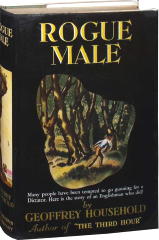
When the war did break out, at least one British general, who himself was a big game hunter, had to be talked out of trying to duplicate Household’s novel in the real world.
Bringing the book to the screen was no easy task. The novel, written in the first person, is a curiously compelling and believable work. It reads like the actual memoir of the narrator and builds incredible suspense.
Finding the right actor to play the lead was vital. It needed someone stalwart and serious yet human and likable — after all, the United States was not in the war, and this was a film about assassinating the leader of another country. Warner Brothers may have fired the opening salvo with Confessions of a Nazi Spy, but not all Americans were convinced the war was any of our business. Pearl Harbor would soon change that, but not yet.
Which is why Walter Pidgeon was the ideal choice to play the lead, that sane, strong, yet gently humorous Canadian actor who in Mrs. Miniver would shortly become the very icon of calm British courage in the face of incredible odds. The simple fact that Pidgeon was the man behind the telescopic sites let the viewer know that he was not only the hero, but he was justified in his actions.
The existence of actors like Pidgeon was one of the strengths of the old studio star system. His very presence told the audience as much as any dialogue could reveal.
The film opens with Pidgeon in what is obviously Germany, near what is obviously Hitler’s Bavarian escape Berchtesgarten. Pidgeon, a famous British hunter, is hunting stags when he realizes where he is, and for reasons he can’t explain decides to see if he could get a clear shot at the dictator. Not that he would ever pull the trigger …
But when he is caught it isn’t so easy to explain. The Germans, particularly George Sanders, are sure he is a British agent, and even if he isn’t, the provocation of a Brit caught trying to kill the Fuehrer is to good to pass up. They beat and torture him, and then plan to dump his body, but he outwits them and escapes.
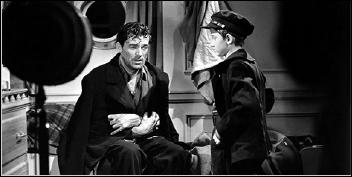
Now the manhunt is on. Pidgeon is hidden on a boat traveling to England and aided by a cabin boy (Roddy McDowall who teamed with Pidgeon in John Ford’s How Green Was My Valley).
He arrives in England only to find there is no where to turn and no one to help him. He can’t go to the police and he soon finds Sanders and his men in England are on his trail.
He’s trapped in a nightmare and can’t wake up. His brother wants nothing to do with him, the government would just as soon he go away, the police would as soon arrest him, and he is actively being hunted by enemy agents in his own country.
After a narrow escape in the London underground with sinister John Carradine, Pidgeon knows his only hope is to go to ground in the wild, where he has a chance based on his survival skills. It’s a splendidly shot sequence that reminds of Lang’s brilliant use of shadow and light in his silent work.
But he needs help, and that comes in the form of Joan Bennett, a prostitute he has picked up in escaping the German agents. (Production code or not the movie is pretty obvious what Bennett’s profession is.) Though she is clearly from another class he is charmed by her, and she by his gentlemanly ways. She agrees to help him, and he in return arranges to help her escape her life.
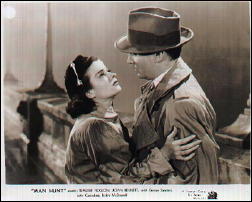
He arranges with his solicitor, one of the few friends he can rely on, to help her while he is in hiding. In the novel the solicitor is Jewish, in the film that’s never exactly said, though perhaps subtly implied.
The scenes between Pidgeon and Bennett are touching and human. When he leaves her he gives her a little token, A pin, a metal arrow, to remember him by.
As you might guess, that pin is going to be important.
Meanwhile after a tearful goodbye in the fog on Tower bridge (and an infamous mistake that puts Parliament on the wrong side of the Thames), Pidgeon heads for the country and finds a small cave he converts into a hideout sets out to keep a low profile.
But Sanders is hot on his trail and tracks him down. Now Pidgeon is pinned in his little hideout with Sanders outside promising to let him live if he will just sign a confession he intended to kill Hitler. And to break Pidgeon’s will he produces proof there is no hope.
The arrow pin Sanders took from Bennett when he tortured and killed her to find out where Pidgeon was hiding.
But Pidgeon didn’t go to ground because it would make him defenseless. He may be trapped but he still has his mind. Using a board from his bed, some rope, his belt, a stick and the arrow pin, Pidgeon builds a makeshift crossbow.
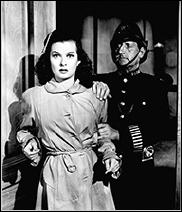
If he can only lure Sanders to the small opening by pretending to sign the confession — before Sanders kills him.
The film ends with Pidgeon enlisted after the war starts in the RAF. But on a mission over Germany he produces his hunting rifle and parachutes from the plane. This time he will hunt the beast from rooftops, not forests, and this time we are assured, he won’t miss.
The novel ends somewhat differently in that we learn that the narrator unconsciously intended to kill the dictator all along. His lover was killed in the Spanish Civil War, but as in the film the book ends as he returns to Germany determined this time to finish the job he began.
It’s hard to gauge just how comforting that thought was to millions of Brits and Americans, the idea that somewhere in Germany one lone man with a gun was stalking the biggest monster of them all. The book was an international sensation and many actually believed a British big game hunter was loose in Europe stalking the German dictator. It was no longer a novel or a film, it had become an urban legend.
Rogue Male was remade under its original title by Clive Donner with Peter O’Toole as the hunter and Sir John Standing in the Sanders role. It was an excellent film, somewhat closer to the novel than the Lang version and featuring one of the last performances of Alistair Sim.
Geoffrey Household went on to write many classic novels of chase and pursuit including Watcher In the Shadows, The Courtesy of Death, Dance of the Dwarfs, and not long before his death the long awaited sequel to Rogue Male, Rogue Justice, which for the first time reveals the characters name and follows his mission in Nazi Germany and his final fate in post war Africa. It is one of the few sequels worthy of the original.
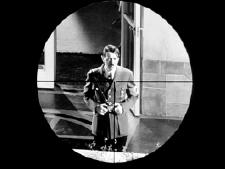
But nothing could recreate the impact of Rogue Male or the Fritz Lang film version, Man Hunt. At a time when the world seemed to have gone mad and the forces of darkness threatened to overwhelm the forces of decency and hope, the idea that somewhere one sane man opposed the darkness, alone and with a gun from the shadows and rooftops, filled a need for hope and a spirit of resistance.
Postwar study of German secret correspondence even revealed they took it seriously, thinking Household’s novel was based on an actual person. Many a rooftop was scanned looking for Household’s fictional hunter.
Man Hunt is a fine film, one of Lang’s best American films, and features a strong screenplay by John Ford favorite, Dudley Nichols. The cast is first rate, with Pidgeon, Sanders, and Bennett all outstanding in their roles. Roddy McDowall is touching in a small but key role, and John Carradine is at his sinister best.
I defy you not feel like cheering even today as Pidgeon descends through the clouds, and we are told this time he won’t miss. It is old Hollywood at its best.
And time has given both film and book a deeper meaning. Today in the light of Lee Harvey Oswald and others, both have an ambiguity never intended at the time. Reading Rogue Male or viewing Man Hunt today might best be accompanied by Frederick Forsyth’s Day of the Jackal and the Fred Zinneman film of that book.
Still, in 1941 when Man Hunt hit the big screen, there was no ambiguity. We knew right and wrong then and we knew what was needed. It was a darker and simpler time and one man with a gun could matter — or at least it seemed that way, and as symbols of hope went, it proved a remarkably resilient and powerful one.
September 29th, 2009 at 4:42 pm
There’s mention in FROM CALIGARI TO HITLER about a fascination in early German movies with the Circle and the anarchy it symbolized in those formative teutonic films; I was delighted to find the motif reappear in MAN HUNT with images like the telescopic sight on a rifle and the sinister shadows highlighting George Sanders’ monocle.
Why did monocles go out of fashion, anyway?
September 29th, 2009 at 9:09 pm
Dan
I know you were just kidding, but the monocle developed from the pince nez, a pair of spectacles without ear pieces on a silk or satin tie that was worn around the time of Beau Brummel as a fashion accessory. That gradually morphed into the monocle, that had the additional value that many Prussian noblemen had some eye damage from those famous dueling scars. The monocle served a dual purpose for them (I apologize for the pun).
Books and movies made the monocle so identified with villains that by the time of WW II they were just associated with bad guys, though Sapper’s Jim Maitland had a famous ‘glass eye’, and at least one French hero known as the Monocle sported one. John Creasey’s the Toff used one in his calling card though I can’t recall him wearing one.
Danny Kaye had a good time trying to keep one in the right eye in On the Double and The Inspector General, and Bob Hope in My Favorite Spy.
But they seem to have gone the way of spats, sword sticks, black homburgs, and gentleman’s gloves as an accessory.
May 13th, 2011 at 1:21 pm
cornball film Bennet’s cockney is hiliarious; almost as trite as the dialogue
January 30th, 2023 at 9:09 am
Excellent review of this classic that Hitchcock must have greatly admired. One of things that made it so effective was the “Nazis†never spoke English to each other, only German, a touch of welcome realism in this sort of wartime adventure – no English translation necessary. One minor point: Our hero used one of his bootlaces, not rope, to help fashion the ingenious weapon. Finally, the beautiful score was as memorable as the movie. Four stars.